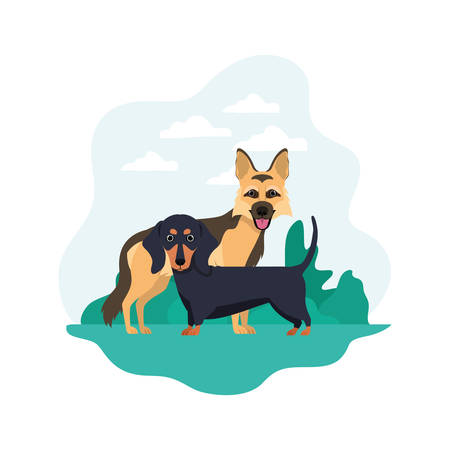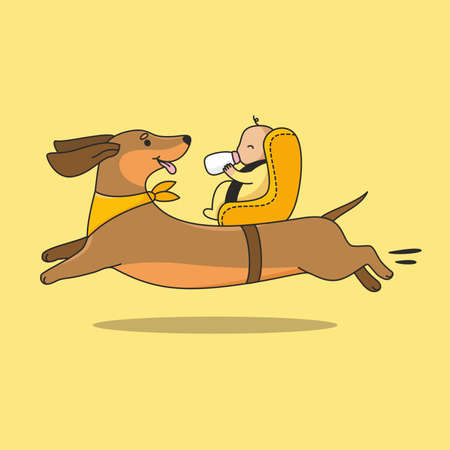1. Why Exercise Matters for Your Dog
Regular physical activity is essential for maintaining your dogs overall health and well-being. It helps with weight management, cardiovascular health, and mental stimulation. Just like humans, dogs need consistent exercise to stay fit and happy.
Physical Health Benefits
Exercise plays a critical role in keeping your dog physically healthy. Here are some key benefits:
| Benefit | Description |
|---|---|
| Weight Management | Helps prevent obesity by burning excess calories and maintaining a healthy weight. |
| Cardiovascular Health | Strengthens the heart and improves circulation, reducing the risk of heart disease. |
| Joint and Muscle Strength | Keeps muscles strong and joints flexible, which is especially important for aging dogs. |
| Digestive Health | Encourages regular digestion and prevents constipation. |
Mental and Emotional Benefits
Exercise isnt just about physical health—it also has a significant impact on your dogs mental well-being. A bored or under-stimulated dog may develop behavioral issues such as excessive barking, chewing, or digging.
- Reduces Anxiety and Stress: Physical activity releases pent-up energy and promotes relaxation.
- Improves Socialization: Walks and playtime allow your dog to interact with other dogs and people.
- Prevents Destructive Behavior: A tired dog is a well-behaved dog. Regular exercise keeps them engaged and less likely to act out.
How Much Exercise Does Your Dog Need?
The amount of exercise your dog needs depends on their breed, age, and overall health. Heres a general guideline:
| Dog Type | Recommended Daily Exercise |
|---|---|
| Small Breeds (e.g., Chihuahua, Pomeranian) | 30-45 minutes of light activity like walks or indoor play. |
| Medium Breeds (e.g., Cocker Spaniel, Border Collie) | 1-2 hours of moderate activity including walking, running, or fetch. |
| Large Breeds (e.g., Labrador Retriever, German Shepherd) | 1.5-2.5 hours of vigorous activity such as hiking or swimming. |
| Seniors or Dogs with Health Issues | 30 minutes of gentle exercise tailored to their needs. |
Signs Your Dog Needs More Exercise
If youre unsure whether your dog is getting enough exercise, watch for these signs:
- Restlessness: Pacing around the house or unable to settle down.
- Weight Gain: Unexplained increase in weight despite a controlled diet.
- Excessive Barking or Chewing: Boredom-driven behaviors due to lack of stimulation.
- Poor Sleep Patterns: Difficulty sleeping through the night or frequent waking up.
The Key Takeaway
Your dogs physical and mental health greatly depends on regular exercise. Finding the right balance based on their breed, age, and energy level ensures they stay happy and healthy. In the next section, well explore different types of exercises that best suit your furry friend!
2. Physical Benefits of Regular Exercise
Keeping your dog active isn’t just about burning off extra energy—it plays a crucial role in their overall health. Regular exercise helps maintain a healthy weight, strengthens muscles and joints, improves heart function, and enhances flexibility, reducing the risk of injuries and chronic diseases.
Preventing Obesity
Obesity is one of the most common health issues in dogs and can lead to serious conditions like diabetes, joint problems, and heart disease. Exercise helps burn excess calories and keeps your dog at a healthy weight.
Stronger Muscles and Joints
Just like humans, dogs need strong muscles and joints to stay active and mobile as they age. Regular movement helps build muscle strength and supports joint health, reducing the risk of arthritis and mobility issues.
Improved Heart Health
A strong heart is essential for a long and healthy life. Exercise increases cardiovascular endurance, helping your dogs heart pump blood more efficiently and keeping their circulatory system in top shape.
Enhanced Flexibility
Stretching and movement improve flexibility, which lowers the risk of injuries. Dogs that engage in regular physical activity are less likely to experience muscle stiffness or strains.
Summary of Physical Benefits
| Benefit | Description |
|---|---|
| Weight Management | Helps prevent obesity by burning excess calories. |
| Muscle & Joint Strength | Keeps muscles strong and supports joint health. |
| Heart Health | Improves cardiovascular endurance and circulation. |
| Flexibility | Lowers the risk of injuries by improving movement. |
By making exercise a part of your dog’s daily routine, you’re giving them the best chance at a long, happy, and healthy life.

3. Mental and Behavioral Benefits
Regular exercise isnt just about keeping your dog physically fit—it also plays a crucial role in their mental well-being and behavior. Without enough activity, dogs can become anxious, bored, or even destructive. A tired dog is a happy dog, and daily exercise helps prevent unwanted behaviors caused by excess energy.
Reduces Anxiety and Stress
Exercise helps release pent-up energy and reduces stress levels in dogs. Just like humans, dogs experience anxiety, and regular physical activity can help alleviate symptoms by promoting relaxation and reducing nervous energy.
Prevents Boredom and Destructive Behavior
Dogs that don’t get enough stimulation often resort to chewing furniture, excessive barking, or digging holes in the yard. Engaging them in daily walks, playtime, or interactive activities keeps their minds occupied and prevents destructive tendencies.
Provides Mental Stimulation
Mental stimulation is just as important as physical exercise. Activities like fetch, agility training, and puzzle toys challenge your dogs brain and improve problem-solving skills. Combining physical activity with mental challenges leads to a more balanced and satisfied pet.
Promotes Good Socialization Skills
Regular exercise often involves interactions with other dogs and people, helping your pup develop good social skills. Meeting new friends at the park or during neighborhood walks teaches them how to behave properly around others, reducing aggression or fear-based reactions.
How Exercise Benefits Your Dog’s Behavior
| Benefit | Description |
|---|---|
| Less Anxiety | Physical activity helps release stress and promotes relaxation. |
| No More Boredom | A busy dog is less likely to engage in destructive behaviors. |
| Mental Stimulation | Puzzle toys and agility exercises keep your dog’s mind sharp. |
| Better Social Skills | Your dog learns how to interact positively with others. |
The mental and behavioral benefits of regular exercise are just as important as the physical ones. Ensuring that your dog gets enough activity each day will lead to a happier, healthier, and better-behaved companion.
4. How Much Exercise Does Your Dog Need?
Exercise needs vary based on breed, age, and health condition. Ensuring your dog gets the right amount of physical activity is essential for their overall well-being. Too little exercise can lead to obesity and behavioral issues, while too much can cause exhaustion or joint problems.
Understanding Your Dogs Exercise Requirements
Every dog has different exercise needs. Factors such as size, energy level, and health status all play a role in determining how much activity they require daily. Below is a general guide to help you understand how much exercise your dog may need:
| Dog Type | Recommended Daily Exercise |
|---|---|
| Small Breeds (e.g., Pugs, Chihuahuas) | 30–45 minutes |
| Medium Breeds (e.g., Beagles, Cocker Spaniels) | 45–60 minutes |
| Large Breeds (e.g., Labrador Retrievers, German Shepherds) | 1–2 hours |
| High-Energy Breeds (e.g., Border Collies, Huskies) | 2+ hours |
| Seniors or Dogs with Health Issues | Adjust based on vet recommendations |
Signs Your Dog Needs More or Less Exercise
Signs They Need More Exercise:
- Excessive barking or destructive behavior
- Restlessness and hyperactivity at home
- Weight gain and low energy levels
Signs They May Be Over-Exercised:
- Limping or reluctance to move after activity
- Panting excessively even after resting
- Lack of interest in playing or going for walks
Customizing an Exercise Plan for Your Dog
The best way to determine the right exercise routine for your dog is by observing their behavior and consulting your veterinarian. Some dogs thrive on long hikes and runs, while others prefer shorter but more frequent walks. Consider mixing up activities such as fetch, agility training, or swimming to keep things fun and engaging.
No matter the breed or age, regular exercise is key to a happy and healthy dog. By understanding your dogs specific needs, you can ensure they stay active without overdoing it.
5. Fun Ways to Keep Your Dog Active
Keeping your dog active doesnt have to be a chore—it can be a fun and rewarding experience for both of you! Regular exercise helps maintain your dogs physical health, prevents obesity, and strengthens your bond. Here are some exciting ways to keep your pup moving.
Daily Walks
Walking is one of the easiest and most effective ways to ensure your dog gets enough exercise. Try varying your route to keep things interesting, and allow your pup time to explore new scents and surroundings.
Fetch Games
A classic game of fetch is an excellent way to burn energy. Use different toys like balls, frisbees, or even soft chew toys to keep things exciting. If you have access to a large open space, this can be a great high-energy activity.
Agility Training
If your dog enjoys challenges, agility training is a fantastic way to engage their body and mind. Set up an obstacle course in your backyard using tunnels, jumps, and weave poles. Many communities also offer agility classes that provide structured training.
Hiking Adventures
If you love the outdoors, take your dog on hiking trails. This provides great exercise while allowing them to explore nature. Be sure to bring plenty of water and check if the trail is pet-friendly before heading out.
Interactive Playtime
Playtime can be as simple as tug-of-war or hide-and-seek inside your home. These activities stimulate both physical movement and mental engagement, making them perfect for rainy days.
Exercise Options at a Glance
| Activity | Benefits |
|---|---|
| Daily Walks | Maintains joint health, improves cardiovascular fitness |
| Fetch Games | Boosts endurance, strengthens muscles |
| Agility Training | Enhances coordination, builds confidence |
| Hiking | Mental stimulation, full-body workout |
| Interactive Playtime | Keeps indoor dogs engaged, prevents boredom |
No matter which activities you choose, the key is consistency. Find exercises that match your dogs energy level and personality, and make them a regular part of your routine!


